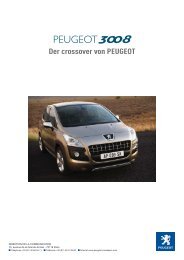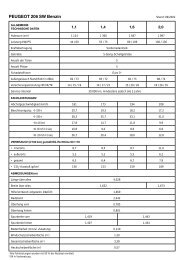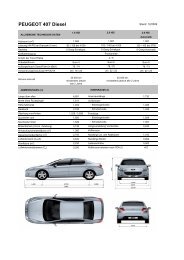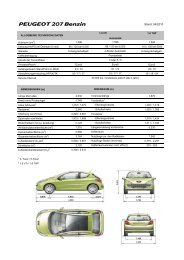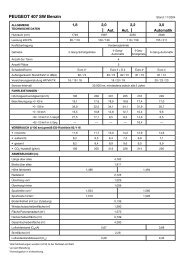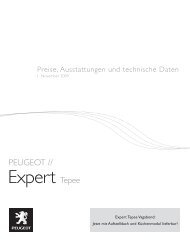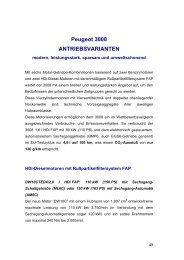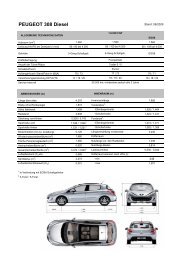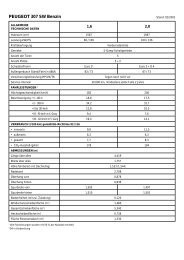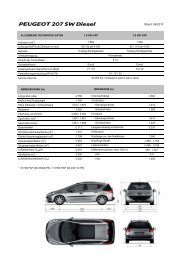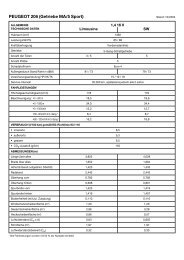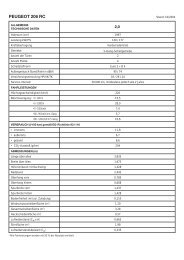PSA COUV page . page RA GB - PEUGEOT Presse
PSA COUV page . page RA GB - PEUGEOT Presse
PSA COUV page . page RA GB - PEUGEOT Presse
Create successful ePaper yourself
Turn your PDF publications into a flip-book with our unique Google optimized e-Paper software.
Corporate Citizenship<br />
AUTOMOTIVE SAFETY FACTS & FIGURES<br />
• Two road test centers: Belchamp and La Ferté-Vidame.<br />
• 18 million kilometers of road tests in 2002 (409 times around the world).<br />
• A patented multi-grip track for braking tests.<br />
• A roadhandling track for ESP/ASR.<br />
• A passive safety center with a full-size catapult, reverse catapult, pedestrian impact<br />
bench, etc.<br />
• 600 complete crash tests and 500 physical tests on automotive subsystems in 2002.<br />
• 3,000 digital crash simulations a year (entire vehicles and subsystems).<br />
• 175,000 hours of simulation on a Cray supercomputer (complete crash simulations).<br />
• Aggregate computation capacity of 1,013 gigaflops, up from 160 gigaflops at end-1999<br />
(1 gigaflop = 1 billion operations per second).<br />
• 60 crash test dummies (unit value: €150,000).<br />
Improving safety accounts for 10% of the Automobile Division’s R&D budget<br />
• Active restraint systems, a major<br />
technological breakthrough<br />
A study of 1,250 serious accidents found<br />
that the use of active restraint systems,<br />
such as seatbelts and airbags, resulted in<br />
an 80% reduction in head and chest injuries.<br />
Fastening the seatbelt, even for short trips,<br />
delivers effective protection.<br />
Seatbelt reminder system<br />
A light warns drivers that seatbelts have<br />
not been fastened and stays on until all<br />
seatbelts are buckled. Just wearing a seatbelt<br />
would reduce the number of fatalities in<br />
French car wrecks by 25%, saving 1,250 lives<br />
a year.<br />
Improving seatbelt-airbag calibration,<br />
based on the full range of passenger<br />
compartment parameters<br />
All <strong>PSA</strong> Peugeot Citroën vehicles are<br />
equipped with three-point seatbelts,<br />
pretensioners and load limiting retractors.<br />
Before the airbag deploys in a collision<br />
sequence, the passenger is pulled tight<br />
to the seat by a traction force of 80 to<br />
100 kilograms, compatible with rib cage<br />
strength, even in the elderly. This action<br />
restricts the passenger’s movement by a<br />
few precious centimeters in the event of an<br />
impact.<br />
Airbags “dampen” violent contact between<br />
occupants and passenger compartment<br />
components. Airbag deployment significantly<br />
reduces the deceleration that such contact<br />
might inflict on the brain, possibly causing<br />
serious, even fatal, injury.<br />
The vast majority of the crash tests conducted<br />
during model development are dedicated<br />
to determining passenger compartment<br />
parameters and to the crucial process of<br />
calibrating the seatbelt/airbag system to<br />
make it effective in a wide variety of accident<br />
configurations.<br />
Active headrests and footrests<br />
These innovative devices have been<br />
introduced as standard equipment on the<br />
Peugeot 307. The active headrest is designed<br />
to prevent whiplash. The active footrest<br />
moves back at the same time as the<br />
bulkhead crosspiece (the part separating<br />
the engine compartment from the<br />
passenger compartment) to prevent often<br />
84<br />
<strong>PSA</strong> <strong>PEUGEOT</strong> CITROËN - MANAGING BOARD REPORT



